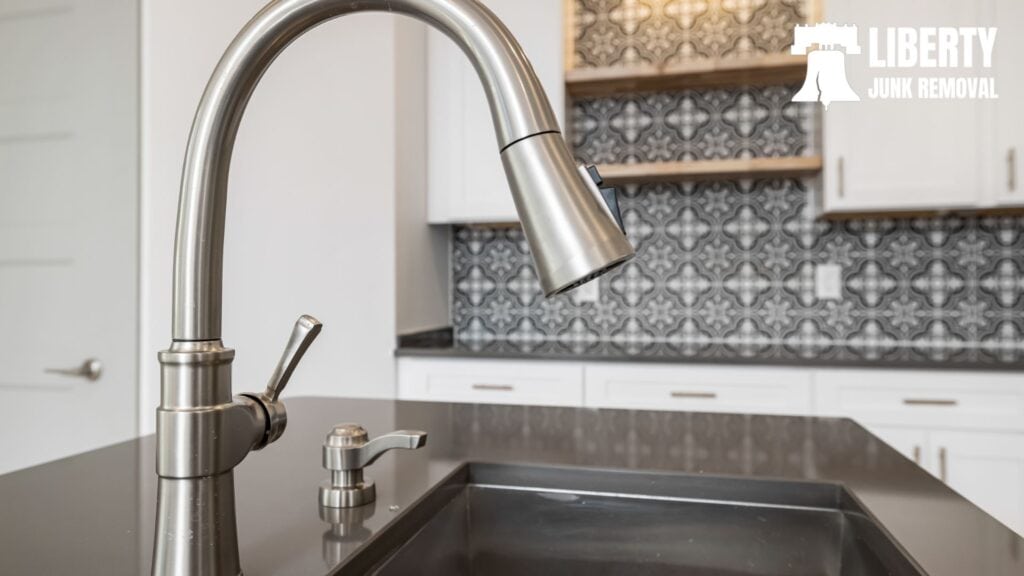Granite countertops have been the reigning queens (and kings) of many kitchens and bathrooms due to their timeless beauty and durability. However, there comes a time in many homeowners’ lives when they contemplate a change or a badly needed upgrade, which leads them to thinking – “How to remove granite countertops?” Can you relate?
Removing granite countertops requires caution to prevent damage. Start by disconnecting utilities, then use a pry bar to gently lift the countertop away from the cabinets. Finally, remove any adhesive residue and clean the area. Seek professional help if uncertain.
While it can sound a bit intimidating, with the right tools, a sprinkle of patience, and a dab of elbow grease, you might just find it’s easier than you think. But how? Read on.
Tools and Materials Needed

Granite is not only heavy but can be delicate, and having the right equipment on hand is crucial. Here’s a quick rundown of the materials you must have on-hand:
- Pry Bar. This tool will help you gently lift the granite from its base without cracking it.
- Putty Knife. This is especially handy for the tight spots and for detaching the granite from any adhesive.
- Utility Knife. Use the tool to slice through any stubborn caulk or sealant that’s holding the countertop to the wall or backsplash.
- Screwdriver Set. Since different sinks are installed with different types of screws, having a set of the tool ensures you’re going to get the job done.
- Gloves. Granite edges can be sharper than they look, and gloves can also minimize the risks of unnecessary scrapes.
- Safety Goggles. You wouldn’t want a stray piece of granite in your eye, so practice safety.
- Bucket and Towels or Rags. A bucket is great for collecting any debris, and rags come in handy for quick clean-ups.
Steps to Disconnect the Sink and Faucet

Before removing granite, it’s important to deal with the sink and faucet first. Let’s break this down step by step:
Step 1: Shut Off the Water Supply
Typically, there are shut-off valves located beneath the sink for both the hot and cold water. Turn them clockwise to shut them off. If for any reason you can’t locate these valves, you may need to shut off the main water supply to the house temporarily.
Step 2: Disconnect the Water Lines
Once the water is off, place a bucket beneath the sink to catch any residual water. Using a wrench, carefully disconnect the water lines leading to the faucet.
Step 3: Remove the Sink Drain Pipes
This might be a bit messy, so have the rags ready. Detach the P-trap (the U-shaped pipe) from the sink drain line. It’s essential to note that over time, sediment can accumulate in the P-trap, so be prepared for a bit of sludge.
Step 4: Loosen and Remove Sink Clips
Your sink is likely held in place with clips attached to the underside of the counter. Using your trusty screwdriver, loosen these clips to free the sink.
Step 5: Lift Out the Sink
Once everything is detached, and the sink is free, carefully lift it out. This is heavy, so it’s a good idea to have an extra pair of hands. If the sink doesn’t budge, it might be caulked to the countertop. In this case, run your utility knife around the sink’s edge to break the seal.
Step 6: Remove the Faucet
Unscrew any mounting nuts holding the faucet in place and gently lift it out.

Steps to Remove the Granite Countertop
With the sink and faucet out of the picture, it’s time to deal with the granite. While it is one of nature’s toughest rocks, with meticulous planning, patience, and the right approach, you can get this done. And here are the steps to follow:
Step 1: Remove Any Backsplash
If your granite countertop is paired with a granite backsplash, use your utility knife to slice through any caulking or adhesive connecting the backsplash to the wall. Then, with your pry bar, gently lift and detach the backsplash from the wall.
Step 2: Cut Caulk and Adhesive Connections
Use your utility knife to cut through any sealants, caulk, or adhesive connecting the granite to your cabinets and wall. Remove as much as possible, as these sealants are designed to be incredibly durable.
Step 3: Begin the Lifting Process
Insert your pry bar at one end of the granite, preferably at a corner or a weak point. With gentle and consistent force, begin to lift. Work your way around the countertop, lifting it bit by bit. Be careful not to exert too much force in one area to prevent any cracks or breaks.
Step 4: Seek Assistance for Larger Slabs
If your countertop is a large slab, it’s essential to have a friend or family member to assist. This is not just about weight – having two people ensures the slab is balanced and prevents it from snapping or cracking during removal.
Step 5: Dispose of the Removed Granite
Once removed, decide on the next steps for your granite. If it’s still in good shape, you can consider repurposing it, donating, or even selling.
Tips for Safe and Efficient Removal

Anyone who has dealt with this kind of task knows that it is better to work smart than work hard, but best if you can practice both. Here are some tips to get the job safe and efficient:
Wear Protective Gear
The importance of wearing protective gear cannot be stressed enough. Always work with your gloves, safety goggles, and protective footwear on.
Disconnect Utilities
Before starting on any home project, especially ones that deal with fixtures and large installations, make sure that all related utilities are disconnected, such as:
- Gas Lines. If your countertop is near a stove or any gas appliance, double-check the connections. While rare, some homes might have gas connections running close to the countertop area.
- Electrical Outlets. If possible, turn off the power to that particular section of your home from the main switchboard.
- Water Lines. Water leaks can not only damage your property but, when mixed with electrical outlets, can pose significant dangers.
When to Hire a Professional for Granite Countertop Removal

While DIY can be rewarding, you must first assess if you can finish the task or it would be better to hire a pro. Here are the considerations to think about:
Size and Weight Concerns
Granite is dense. On average, it weighs around 18-20 pounds per square foot. Larger countertops can weigh hundreds to over a thousand pounds. Lifting heavy weights without proper technique can cause severe back injuries. So, if you’re not confident in handling the countertop’s weight, it’s best to call professional help.
Intrinsic Value of the Countertop
If you’re removing the granite to repurpose or resell it, any accidental damage could significantly reduce its value. Some granite variants, due to their rarity and quality, can be sold at high prices. In such cases, it’s better to leave the job to a professional’s hands.
Presence of Integrated Features
Some granite countertops come with integrated features like built-in sinks, cooktops, or elaborate edgings. Disconnecting or working around these features without the right expertise can lead to damage.
Limited Manpower
Granite removal isn’t a one-person job. If you’re short on helping hands, it’s time to call in the experts.
Complexity of Installation
Older homes or custom installations might have granite countertops affixed in non-standard ways. In such cases, the removal process could be more complex than anticipated.
Time Constraints
While DIY can be cost-effective, it’s often time-intensive. Professionals, with their experience and tools, can speed up the process.
Minimizing the Risks
Many home insurance policies don’t cover accidents stemming from DIY home renovation projects. This means any damage to your home (or your neighbor’s if you share a wall) during the removal process could be out of pocket. Professionals not only have the expertise to minimize such risks but also come with insurance that covers potential damages.
How to Dispose of Granite Countertops
So, after removing the granite countertop, the obvious next step is what to do with it. Here are some tips on how you can responsibly dispose them of:
If It’s in Good Condition
You can do the following if the countertop is still “usable”:
- Sell or Donate. You can either sell it at online platforms or donate the materials to organizations.
- Repurpose. You can send it to a pro to turn it into a granite-topped coffee table, or break it into pieces and use as garden stepping stones.
- Offer to Friends or Neighbors. Sometimes, the best solutions are the closest. Perhaps a friend, family member, or neighbor is looking to spruce up a small space or undertake a DIY project.
If It’s Not in Good Condition
If you can no longer find any use for the granite countertop, you can bring it to any of the following:
- Recycling Centers. Many cities have recycling centers or facilities that specialize in construction and demolition waste. They grind down granite and other stones to be repurposed into things like roads or other construction materials.
- Landscaping. Broken granite chunks can make unique and rugged stepping stones, bed borders, or even decorative elements in gardens.
- Upcycling. Even if the granite is damaged, smaller intact pieces can be cut and polished to create items like coasters, serving trays, or decorative tiles.
- Dispose Responsibly. If the above options aren’t feasible, ensure that you dispose of the granite responsibly. Check with your local waste management facility on how to discard bulky items like granite countertops.

How to Remove Granite Countertops – FAQ
Let’s address some of the most commonly asked questions related to granite countertop removal.
What is the Cheapest Way to Change Granite Countertops?
Budget is often a crucial factor in home renovations. Here are the cost-effective ways to deal with the budget concerns in changing your granite countertop:
- Refinishing Instead of Replacing. If the issue is primarily cosmetic, consider refinishing the granite. Polishing can remove minor scratches and restore the sheen. Sealing can refresh the surface and offer protection against stains and spills.
- DIY Removal. As discussed earlier, if you have the tools, time, and a couple of helping hands, DIY removal can save labor costs. However, always prioritize safety and know when to call in professionals.
- Upcycle.Instead of discarding the old granite, repurpose it for other projects around the house.
- Bulk Disposal. If you’re doing a complete home renovation, consider using a bulk disposal service for all waste.
Can Granite Countertops be Removed Without Damaging Cabinets?
Cabinets, especially custom ones, can be expensive, and any damage during the countertop removal process can be discouraging. Take note of the following to ensure zero (or minimal) damage to the countertop during the process:
- Gentle Prying. Instead of using excessive force, gently pry the granite from the cabinets. Often, the granite is attached using adhesive, and careful prying can minimize damage.
- Use Shims. Insert wooden shims or plastic wedges between the cabinet and granite. This not only provides leverage but also acts as a buffer, preventing direct contact of tools with the cabinet surface.
- Assess the Attachment. Before starting the removal process, try to understand how the granite is attached. If it’s screwed in place through the cabinets (though rare, it can happen), ensure all screws are removed first.
- Seek Professional Assistance. If you’re unsure about the removal process, especially when preserving the cabinets is a priority, it might be worth investing in professional services.
Can Granite Countertops be Removed Easily?
Aside from being aesthetically pleasing, granite countertops are durable and last long in good condition. Granites are built to last, a trait that makes their removal challenging. But can they be removed easily?
- Dependence on Adhesive. Granite countertops are typically held in place by a strong adhesive. The type and amount of adhesive can significantly influence the ease of removal. Some modern adhesives are designed for easier reversibility, while older, traditional types can be quite stubborn.
- Weight and Size. The sheer weight and size of the granite can make maneuvering and handling challenging.
- Integration with Other Features. Each additional integrated feature that comes with the countertop increases the intricacy of the removal process.
- Risk of Damage. Granite, though hard, is also brittle. Applying uneven or excessive force can lead to breakage.
A Pat on the Back for a Job Well Done!
Home renovations are transformative experiences, not just for our homes but for us as well. While we may be tempted to DIY in many home projects, there are cases when we have to pause and weigh its pros and cons. It can be rewarding to remove granite countertop on your own, but will it be worth it?
Clear the Clutter with the Best Solution for Big Item Disposal
Once the heavy granite countertop is off and you’re sure you want to have it out of your home, you may be left thinking – now, what? When you’re faced with large items like old appliances and a bulky and heavy countertop, don’t stress! Liberty Junk Removal is here to make your life easier. We’re experts at dealing with the heavy, hard-to-handle stuff that’s cluttering up your home or workspace. If you’re contemplating clearing out your space, remember that this reliable junk removal company in Philadelphia is just a call away!







